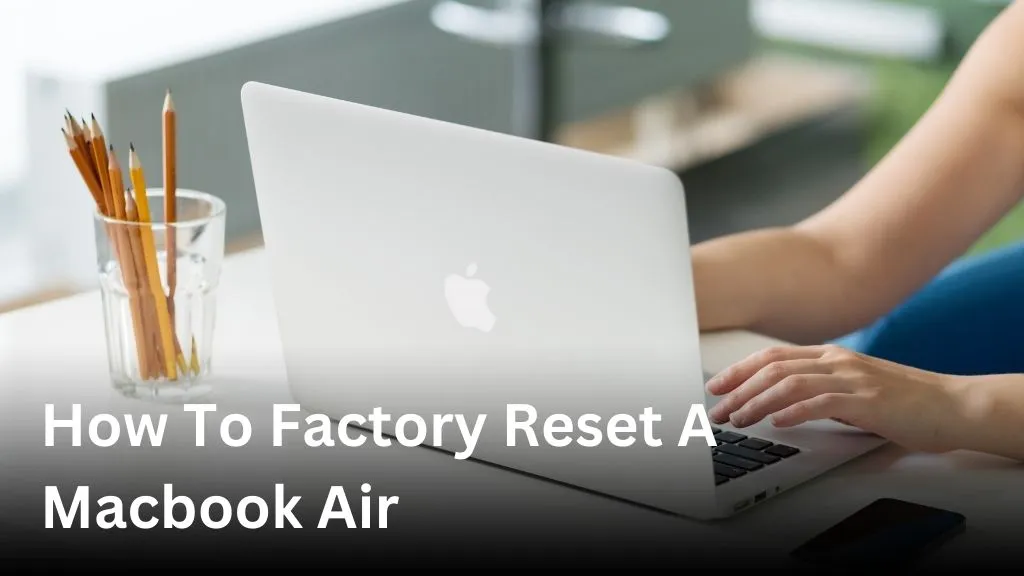Welcome to our comprehensive guide on how to perform a factory reset on your MacBook Air. Whether you’re looking to start fresh or troubleshoot issues, a factory reset can be a valuable solution. In this article, we will provide you with step-by-step instructions to ensure a successful reset process. So, let’s dive in and learn how to reset your MacBook Air.
Table of Contents
ToggleUnderstanding the Factory Reset Process
Before diving into the steps of a factory reset for your MacBook Air, it’s essential to understand what this process entails. By performing a factory reset, you can restore your device to its original settings, erasing all data and applications. This can be incredibly useful if you want to start afresh, troubleshoot issues, or prepare your MacBook Air for resale.
A factory reset wipes all personal data, settings, and configurations from your MacBook Air. It reinstalls the operating system, giving you a clean slate to work with. Keep in mind that a factory reset should be approached with caution, as it’s irrecoverable and permanently erases all data.
Performing a factory reset offers several benefits. It allows you to:
- Resolve software issues or unusual behavior by removing any potentially conflicting apps or configurations.
- Start fresh with a clean slate, particularly if your MacBook Air has accumulated clutter over time.
- Clear personal data and settings when preparing to sell or give away your device.
Now that you have a better understanding of what a factory reset entails, let’s proceed to the detailed steps in the next section.
Benefits of Performing a Factory Reset
| Benefit | Description |
|---|---|
| Resolve Software Issues | By removing conflicting apps or configurations, a factory reset can help resolve software issues or unusual behavior. |
| Fresh Start | Starting afresh with a factory reset allows you to eliminate clutter and optimize the performance of your MacBook Air. |
| Data Security | Performing a factory reset ensures that all personal data and settings are permanently erased, maintaining your privacy and security. |
| Device Resale | When preparing to sell or give away your MacBook Air, a factory reset ensures that all personal data is completely wiped, protecting your information. |
Preparing Your MacBook Air for Reset

Before initiating the factory reset process on your MacBook Air, it’s crucial to take the necessary steps to ensure a smooth and successful reset. By following these instructions, you will be able to back up your data, sign out of accounts, and take the essential precautions needed before proceeding.
Step 1: Backing up Your Data
Prior to performing a factory reset, it’s important to create a backup of your important files and documents. This will ensure that you don’t lose any data during the reset process. Follow the steps below to back up your data:
- Connect an external hard drive or use cloud storage services such as iCloud or Dropbox.
- Copy and transfer all your important files, documents, photos, and videos to the external hard drive or cloud storage.
- Double-check that all the necessary files have been successfully backed up.
Step 2: Signing out of Accounts
To prevent any complications or security issues during the factory reset process, it’s recommended to sign out of all your accounts. Follow the steps below to sign out of your accounts:
- Open the respective applications or websites for each account (e.g., iCloud, iTunes, App Store, etc.).
- Sign out of each account individually by going to the account settings section and selecting the “Sign Out” option.
- Confirm the sign-out process for each account.
Step 3: Taking Necessary Precautions
Before proceeding with the factory reset, it’s essential to take some additional precautions to ensure a smooth and hassle-free process. Follow these steps:
- Disconnect any external devices or peripherals connected to your MacBook Air, such as printers, scanners, or external monitors.
- Store all the necessary passwords, serial numbers, and software licenses in a safe place for future reference.
- Ensure that your MacBook Air is connected to a stable power source or fully charged to avoid any interruptions during the reset process.
By completing these preparations, you are now ready to proceed with the factory reset of your MacBook Air.
| Preparation Steps | Details |
|---|---|
| Step 1: Backing up Your Data | Connect an external hard drive or use cloud storage services to back up your important files, documents, photos, and videos. |
| Step 2: Signing out of Accounts | Sign out of all your accounts individually, including iCloud, iTunes, App Store, and any other relevant accounts. |
| Step 3: Taking Necessary Precautions | Disconnect external devices, keep track of passwords and software licenses, and ensure your MacBook Air is connected to a stable power source. |
Performing the Factory Reset
To restore your MacBook Air to its original factory settings and wipe it clean of all data, follow these step-by-step instructions:
- Click on the Apple menu in the top left corner of your screen and select “Restart” to reboot your MacBook Air.
- While your MacBook Air is restarting, press and hold the Command and R keys simultaneously until the Apple logo appears. This will boot your device into macOS Recovery.
- Once in macOS Recovery, select “Disk Utility” and click “Continue”. This will open the Disk Utility window.
- In Disk Utility, select your MacBook Air’s internal drive (usually labeled as “Macintosh HD” or “Macintosh SSD”) from the left sidebar.
- Click on the “Erase” tab at the top of the Disk Utility window.
- Choose the format for your restored MacBook Air. For a clean wipe, select “Mac OS Extended (Journaled)”.
- Enter a name for your MacBook Air’s disk, such as “Macintosh HD”, and click “Erase” to begin the formatting process. Note that all data on the disk will be permanently deleted.
- Once the formatting is complete, close the Disk Utility window.
- In the macOS Utilities window, select “Reinstall macOS” and click “Continue”. Follow the on-screen instructions to reinstall the macOS operating system on your MacBook Air. This process may take some time.
- After the reinstallation is complete, your MacBook Air will restart and prompt you to set up your device as you did when you first bought it.
By following these steps, you can successfully perform a factory reset on your MacBook Air and start fresh with a clean and optimized device.
| Step | Instructions |
|---|---|
| 1 | Click on the Apple menu in the top left corner of your screen and select “Restart” to reboot your MacBook Air. |
| 2 | While your MacBook Air is restarting, press and hold the Command and R keys simultaneously until the Apple logo appears. This will boot your device into macOS Recovery. |
| 3 | Once in macOS Recovery, select “Disk Utility” and click “Continue”. This will open the Disk Utility window. |
| 4 | In Disk Utility, select your MacBook Air’s internal drive (usually labeled as “Macintosh HD” or “Macintosh SSD”) from the left sidebar. |
| 5 | Click on the “Erase” tab at the top of the Disk Utility window. |
| 6 | Choose the format for your restored MacBook Air. For a clean wipe, select “Mac OS Extended (Journaled)”. |
| 7 | Enter a name for your MacBook Air’s disk, such as “Macintosh HD”, and click “Erase” to begin the formatting process. Note that all data on the disk will be permanently deleted. |
| 8 | Once the formatting is complete, close the Disk Utility window. |
| 9 | In the macOS Utilities window, select “Reinstall macOS” and click “Continue”. Follow the on-screen instructions to reinstall the macOS operating system on your MacBook Air. This process may take some time. |
| 10 | After the reinstallation is complete, your MacBook Air will restart and prompt you to set up your device as you did when you first bought it. |
Restoring Your MacBook Air
After completing the factory reset process, you have the option to restore your MacBook Air to its previous state or set it up as a new device. Let’s explore the available options and provide guidance on how to restore your data, apps, and settings.
1. Restoring from Time Machine Backup
If you previously created a backup using Time Machine, you can easily restore your MacBook Air to its previous state by following these steps:
- Connect your Time Machine backup drive to your MacBook Air.
- Restart your MacBook Air and hold down the Option key.
- Select the Time Machine backup drive from the list of startup disks.
- Follow the on-screen instructions to restore your MacBook Air from the Time Machine backup.
2. Setting Up as a New Device
If you prefer starting fresh and setting up your MacBook Air as a new device, follow these steps:
- Go through the initial setup process, including selecting your region and language.
- Sign in with your Apple ID or create a new Apple ID if you don’t have one.
- Agree to the terms and conditions.
- Choose whether you want to enable Siri and other features.
- Customize your settings, such as privacy preferences and screen time settings.
- Install your preferred apps from the App Store and configure them.
- Copy your files and data from external storage devices or the cloud.
By following these steps, you can easily restore your MacBook Air and get it up and running according to your preferences. Whether you choose to restore from a backup or set it up as a new device, make sure to follow the instructions carefully to ensure a successful restoration process.
Conclusion
Performing a factory reset on your MacBook Air can be a valuable solution for enhancing performance and resolving issues. By following the detailed step-by-step instructions provided in this guide, you can safely reset your device and enjoy a clean and optimized MacBook Air experience.
It is crucial to remember to back up your data before initiating the factory reset to prevent any loss during the process. This will ensure that your important files, photos, and documents are securely stored and can be easily restored once the reset is complete.
Whether you want to start fresh or troubleshoot persistent software problems, a factory reset gives your MacBook Air a fresh start and eliminates any clutter or malware that may be affecting its performance. Just make sure to follow the instructions carefully and perform the necessary preparations to ensure a successful reset.
FAQ
What does a factory reset mean?
A factory reset is the process of restoring a device to its original manufacturer settings. It erases all data, apps, and settings, essentially giving you a clean slate as if the device was just taken out of the box.
Why would I want to perform a factory reset on my MacBook Air?
There are several reasons why you might want to factory reset your MacBook Air. It can help improve performance, resolve software issues, remove viruses or malware, and prepare the device for resale or transfer to another user.
Do I need to back up my data before performing a factory reset?
Yes, it is highly recommended to back up your data before initiating a factory reset. This ensures that you don’t lose any important files, documents, or personal information during the process. You can use external hard drives, cloud storage, or Time Machine to create a backup.
How do I back up my data before factory resetting my MacBook Air?
To back up your data, you can use the built-in Time Machine feature on your MacBook Air. Connect an external hard drive and follow the on-screen prompts to set up the backup. Additionally, you can manually transfer important files and documents to an external storage device or use cloud storage services.
What precautions should I take before performing a factory reset?
Before initiating a factory reset, make sure you sign out of all your accounts, such as iCloud, iTunes, and any third-party apps or services linked to your MacBook Air. Additionally, deactivate Find My Mac and ensure that you have the necessary software licenses and product keys for reinstalling apps or operating systems.
How do I perform a factory reset on my MacBook Air?
To perform a factory reset on your MacBook Air, go to the Apple menu, select “Restart”, and hold down the Command and R keys until the Apple logo appears. This will boot your Mac into Recovery Mode. From there, you can choose to reinstall macOS, erase the disk and reinstall macOS, or use Disk Utility to erase and reformat the disk.
Can I restore my MacBook Air after a factory reset?
Yes, after a factory reset, you can restore your MacBook Air either from a Time Machine backup or by manually reinstalling apps, transferring data from external storage, and customizing your settings. The restore process will depend on the method you used to back up your data.
How long does a factory reset on a MacBook Air take?
The time it takes to perform a factory reset on a MacBook Air can vary depending on various factors such as the speed of your device, the amount of data being erased, and the version of macOS. Generally, it can take anywhere from 30 minutes to a few hours.

















